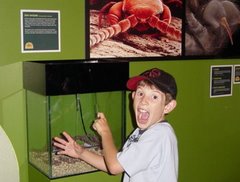Went to this talk today by hosted by Seb Chan at the Powerhouse Museum. Beth runs a blog How NonProfits can use social media among many, many other things.
My notes from the talk and discussion:
Web enables connections with people around topics they are interested in.
Talked us through an interesting example of using Twitter to get some responses to a specific question about travelling to Oz and what phones to use
Also talked about video blogging
It's all about connectedness and the global brain – a 50 years transition that we're in the middle of
Here comes everybody book: talks about implications for social change and renegotiating social contracts
We are all still experimenting – no secret formula yet, sooner you get on and learn and experiment the further ahead you'll be
People are making decisions through their social networks (their friends) – this is how many in younger generations are making their decisions
It's not about the list, it's about the networks – you have a network and everyone n your network has a network and so on
Neilsenbuzzmetrics report looked at where the trust factor is – recommendations from consumers were the number one source people trust (this includes things like writing on your Facebook wall!)
Younger people have reference for communicating through social networks – and they don't necessarily see that work colleagues and the way they talk to their friends is any different
Information comes to me, I don't go and find it (Russ also talked about this as pushing content to people not pulling them in)
Read rates of e-newsletters are pretty low at around 30% - it's all about pushing through, need to find other methods
Need to think about audiences as fans – need to cultivate your fans who don't see one show but will come to you again and again
Beth talked though a fundraising example using social networks – question was how can I use a range of social media tools to raise money? For the Sharing Foundation campaign sought opinions for audience/readers as well as identifying those who were evangelists for the cause and could take it up.
Strategy – make it personal (psychology of influence) not institutional
What about being just one person? Look at the ladder of engagement of givers – instigators, evangelists, donors, spreaders, happy bystanders (each of these varies by participation type and involvement)
The personal fundraiser does the network weaving
Tell a personalised story rather than statistics about an anonymous many
Relationship building using those people that you already know and their networks
Rewards and reciprocity (people will treat you as they have been treated)
Need to give your fans the viral tools to spread the message
Birthday Flickr project remix example – used as a test for people on Flickr to remix fotos and prize was $50 donated to cause of their choice
There will be a special interest group out there about you and your content that you can leverage
Timing is critical – make it close to the opening of the exhibit for example
Important message – let go, you lose control but you gain a lot
Takes time – don't get immediate results, might take several experiments before you leverage a network
How do we gather our evangelists? Museums are still using traditional methods to broadcast to them
Brought up Nina Simon's blog post about how much time Web 2.0 takes which was worth revisiting
Showed David Wilcox changing power relationships slide – a change from top down to bottom up
The long tail of Facebook post – donation base small but reach is very large, frogloop care2 as an example of how to optimise online fundraising
Groundswell by Li and Bernoff – Seb has reviewed this book on fresh+new(er)
Overall, a really worthwhile session – Beth posted an interview with me to her blog too (umm, don't look at the foto!!). Also interesting to see that the PHM staff have the same questions and worries that Australian Museum staff have too – more work for Seb and I to do I fear!



1 comment:
thanks for taking such great notes! It was a pleasure to meet you and to discover your research work. I'm still on the road, but can't wait to print out your paper and read it closely.
Post a Comment